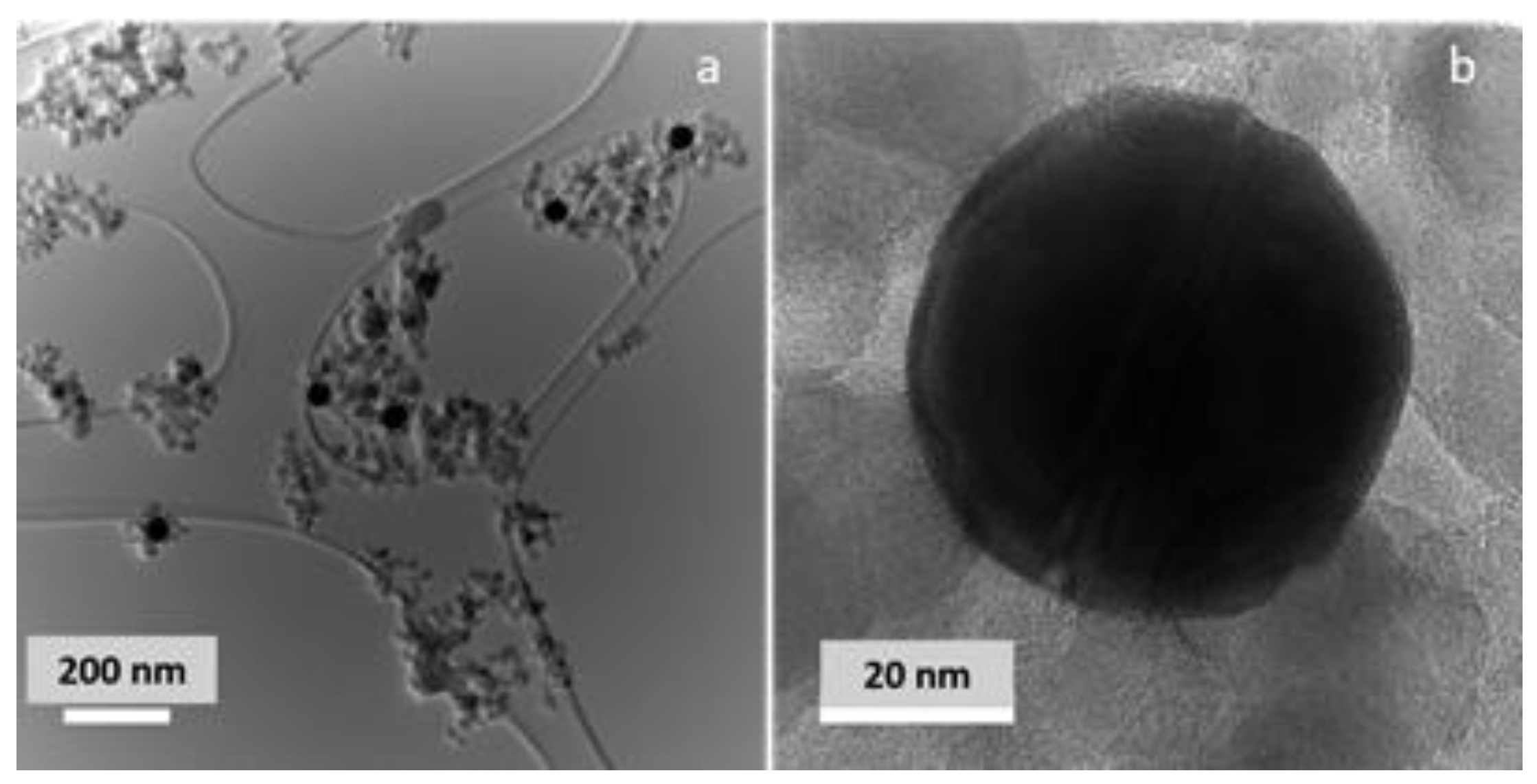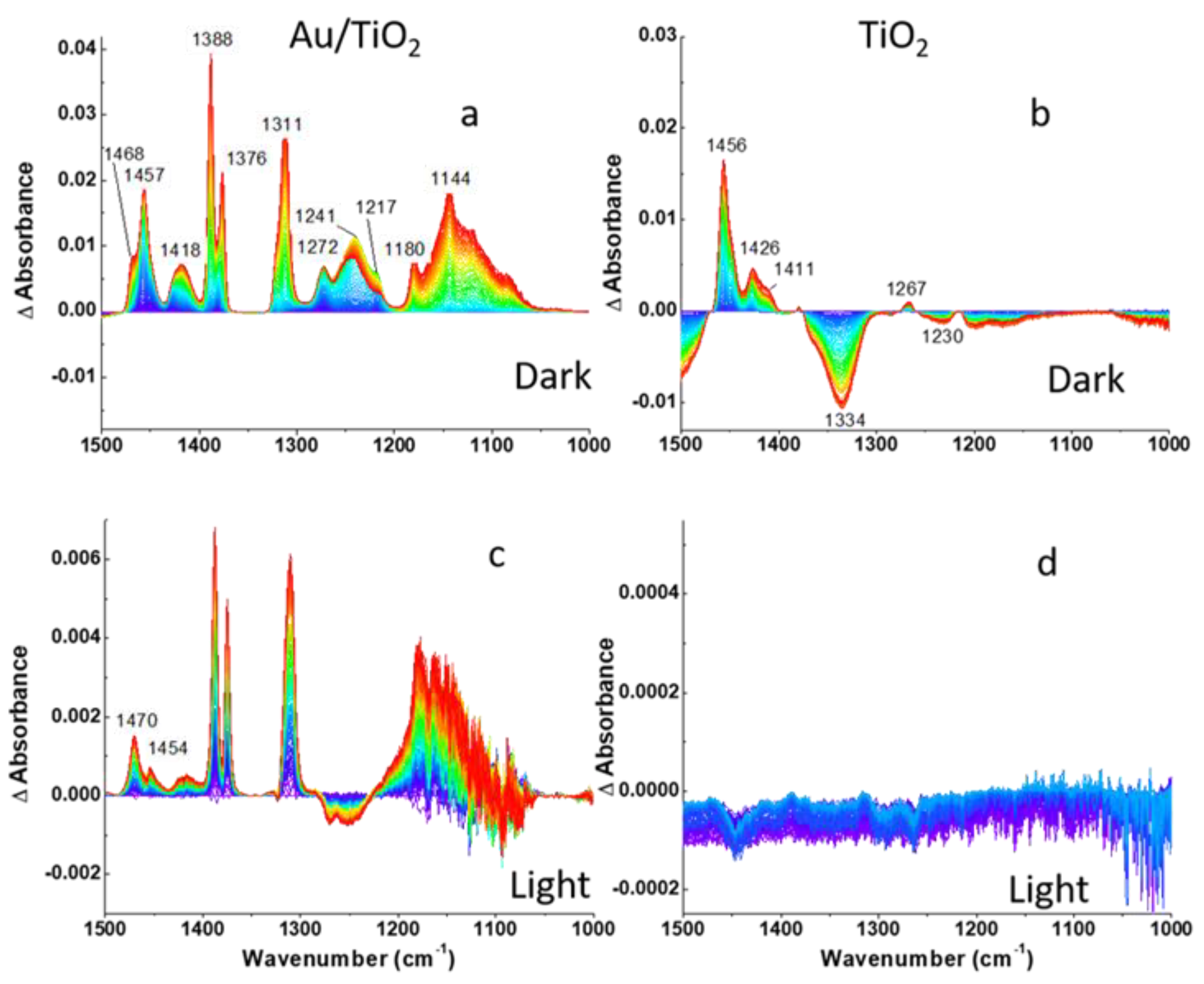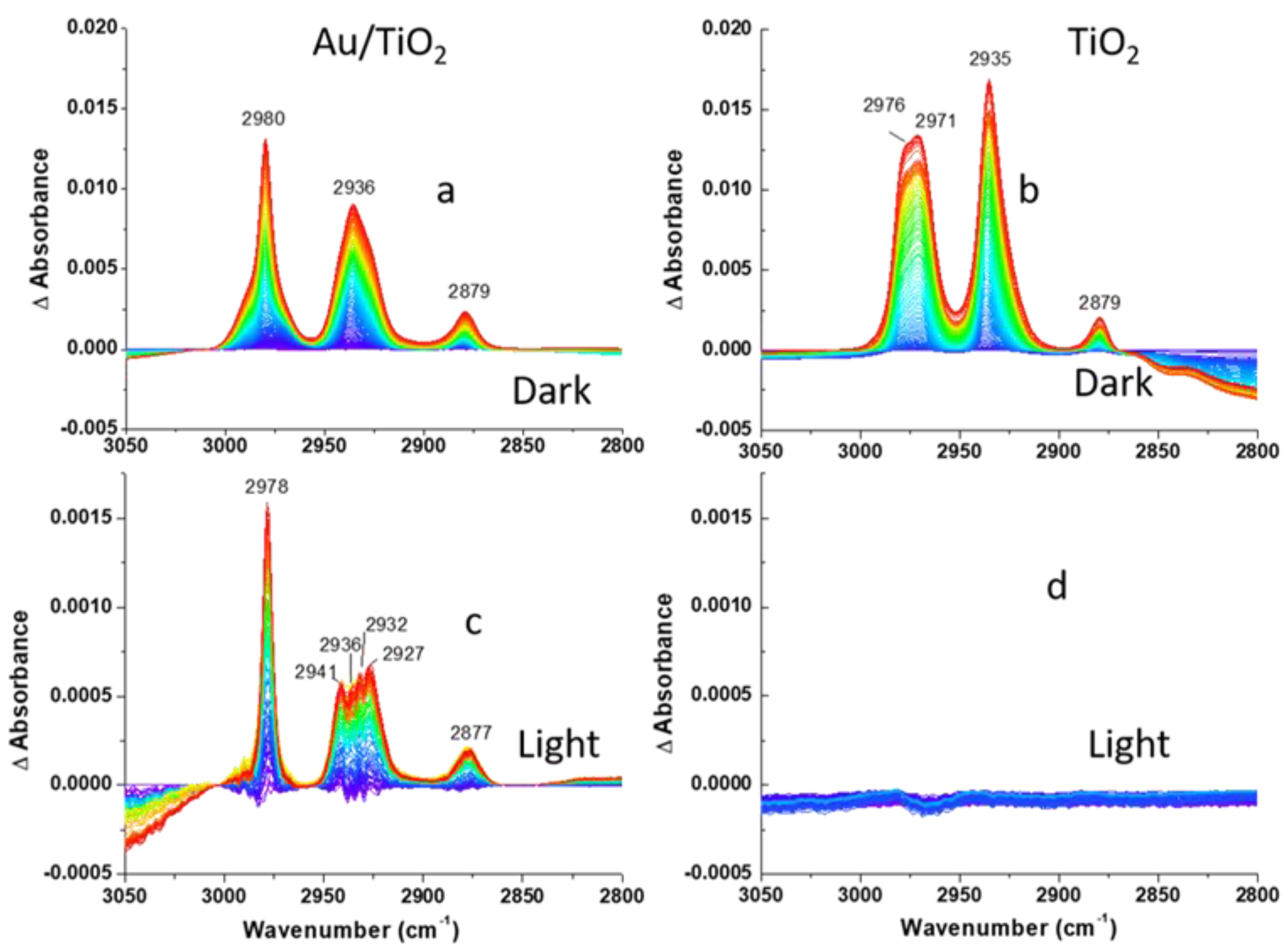Visible Light-Induced Reactivity of Plasmonic Gold Nanoparticles Incorporated into TiO2 Matrix towards 2-Chloroethyl Ethyl Sulfide
Abstract
:1. Introduction
2. Materials and Methods
3. Results and Discussion
3.1. Characterization
3.2. The 2-CEES Reactivity under Anaerobic Conditions
3.3. The 2-CEES Reactivity under Aerobic Conditions
4. Conclusions
Supplementary Materials
Author Contributions
Funding
Acknowledgments
Conflicts of Interest
References
- Naldoni, A.; Riboni, F.; Guler, U.; Boltasseva, A.; Shalaev, V.M.; Kildishev, A.V. Solar-Powered Plasmon-Enhanced Heterogeneous Catalysis. Nanophotonics 2016, 5, 112–133. [Google Scholar] [CrossRef]
- Naldoni, A.; Guler, U.; Wang, Z.X.; Marelli, M.; Malara, F.; Meng, X.G.; Besteiro, L.V.; Govorov, A.O.; Kildishev, A.V.; Boltasseva, A.; et al. Broadband Hot-Electron Collection for Solar Water Splitting with Plasmonic Titanium Nitride. Adv. Opt. Mater. 2017, 5. [Google Scholar] [CrossRef] [Green Version]
- Alvaro, M.; Cojocaru, B.; Ismail, A.A.; Petrea, N.; Ferrer, B.; Harraz, F.A.; Parvulescu, V.I.; Garcia, H. Visible-light photocatalytic activity of gold nanoparticles supported on template-synthesized mesoporous titania for the decontamination of the chemical warfare agent Soman. Appl. Catal. B Environ. 2010, 99, 191–197. [Google Scholar] [CrossRef]
- Neatu, S.; Cojocaru, B.; Parvulescu, V.I.; Somoghi, V.; Alvaro, M.; Garcia, H. Visible-light C-heteroatom bond cleavage and detoxification of chemical warfare agents using titania-supported gold nanoparticles as photocatalyst. J. Mater. Chem. 2010, 20, 4050–4054. [Google Scholar] [CrossRef]
- Valenti, M.; Jonsson, M.P.; Biskos, G.; Schmidt-Ott, A.; Smith, W.A. Plasmonic nanoparticle-semiconductor composites for efficient solar water splitting. J. Mater. Chem. A 2016, 4, 17891–17912. [Google Scholar] [CrossRef] [Green Version]
- Zheng, X.Z.; Zhang, L.W. Photonic nanostructures for solar energy conversion. Energy Environ. Sci. 2016, 9, 2511–2532. [Google Scholar] [CrossRef]
- Bumajdad, A.; Madkour, M.; Abdel-Moneam, Y.; El-Kemary, M. Nanostructured mesoporous Au/TiO2 for photocatalytic degradation of a textile dye: The effect of size similarity of the deposited Au with that of TiO2 pores. J. Mater. Sci. 2014, 49, 1743–1754. [Google Scholar] [CrossRef]
- Dodekatos, G.; Schunemann, S.; Tuysuz, H. Surface Plasmon-Assisted Solar Energy Conversion. In Solar Energy for Fuels; Tuysuz, H., Chan, C.K., Eds.; Topics in Current Chemistry-Series; Springer: Berlin/Heidelberg, Germany, 2016; Volume 371, pp. 215–252. [Google Scholar]
- Lu, Y.; Yu, H.T.; Chen, S.; Quan, X.; Zhao, H.M. Integrating Plasmonic Nanoparticles with TiO2 Photonic Crystal for Enhancement of Visible-Light-Driven Photocatalysis. Environ. Sci. Technol. 2012, 46, 1724–1730. [Google Scholar] [CrossRef]
- Hung, W.H.; Aykol, M.; Valley, D.; Hou, W.B.; Cronin, S.B. Plasmon Resonant Enhancement of Carbon Monoxide Catalysis. Nano Lett. 2010, 10, 1314–1318. [Google Scholar] [CrossRef] [PubMed]
- Rej, S.; Mascaretti, L.; Santiago, E.Y.; Tomanec, O.; Kment, S.; Wang, Z.M.; Zboril, R.; Fornasiero, P.; Govorov, A.O.; Naldoni, A. Determining Plasmonic Hot Electrons and Photothermal Effects during H-2 Evolution with TiN-Pt Nanohybrids. ACS Catal. 2020, 10, 5261–5271. [Google Scholar] [CrossRef]
- Richardson, H.H.; Carlson, M.T.; Tandler, P.J.; Hernandez, P.; Govorov, A.O. Experimental and Theoretical Studies of Light-to-Heat Conversion and Collective Heating Effects in Metal Nanoparticle Solutions. Nano Lett. 2009, 9, 1139–1146. [Google Scholar] [CrossRef] [Green Version]
- Govorov, A.O.; Richardson, H.H. Generating heat with metal nanoparticles. Nano Today 2007, 2, 30–38. [Google Scholar] [CrossRef]
- Cortes, E.; Besteiro, L.V.; Alabastri, A.; Baldi, A.; Tagliabue, G.; Demetriadou, A.; Narang, P. Challenges in Plasmonic Catalysis. ACS Nano 2020, 14, 16202–16219. [Google Scholar] [CrossRef] [PubMed]
- Jauffred, L.; Samadi, A.; Klingberg, H.; Bendix, P.M.; Oddershede, L.B. Plasmonic Heating of Nanostructures. Chem. Rev. 2019, 119, 8087–8130. [Google Scholar] [CrossRef] [PubMed]
- Naya, S.; Teranishi, M.; Isobe, T.; Tada, H. Light wavelength-switchable photocatalytic reaction by gold nanoparticle-loaded titanium(IV) dioxide. Chem. Commun. 2010, 46, 815–817. [Google Scholar] [CrossRef] [PubMed]
- Higashimoto, S. Titanium-Dioxide-Based Visible-Light-Sensitive Photocatalysis: Mechanistic Insight and Applications. Catalysts 2019, 9, 201. [Google Scholar] [CrossRef] [Green Version]
- Kowalska, E.; Abe, R.; Ohtani, B. Visible light-induced photocatalytic reaction of gold-modified titanium(IV) oxide particles: Action spectrum analysis. Chem. Commun. 2009, 241–243. [Google Scholar] [CrossRef]
- Naya, S.; Inoue, A.; Tada, H. Self-Assembled Heterosupramolecular Visible Light Photocatalyst Consisting of Gold Nanoparticle-Loaded Titanium(IV) Dioxide and Surfactant. J. Am. Chem. Soc. 2010, 132, 6292. [Google Scholar] [CrossRef] [PubMed]
- Wang, D.W.; Pillai, S.C.; Ho, S.H.; Zeng, J.B.; Li, Y.; Dionysiou, D.D. Plasmonic-based nanomaterials for environmental remediation. Appl. Catal. B Environ. 2018, 237, 721–741. [Google Scholar] [CrossRef]
- Gelle, A.; Jin, T.; de la Garza, L.; Price, G.D.; Besteiro, L.V.; Moores, A. Applications of Plasmon-Enhanced Nanocatalysis to Organic Transformations. Chem. Rev. 2020, 120, 986–1041. [Google Scholar] [CrossRef]
- Ide, Y.; Matsuoka, M.; Ogawa, M. Efficient Visible-Light-Induced Photocatalytic Activity on Gold-Nanoparticle-Supported Layered Titanate. J. Am. Chem. Soc. 2010, 132, 16762–16764. [Google Scholar] [CrossRef]
- Zheng, Z.K.; Huang, B.B.; Qin, X.Y.; Zhang, X.Y.; Dai, Y.; Whangbo, M.H. Facile in situ synthesis of visible-light plasmonic photocatalysts M@TiO2 (M = Au, Pt, Ag) and evaluation of their photocatalytic oxidation of benzene to phenol. J. Mater. Chem. 2011, 21, 9079–9087. [Google Scholar] [CrossRef]
- Primo, A.; Corma, A.; Garcia, H. Titania supported gold nanoparticles as photocatalyst. Phys. Chem. Chem. Phys. 2011, 13, 886–910. [Google Scholar] [CrossRef] [PubMed]
- Widmann, D.; Behm, R.J. Active Oxygen on a Au/TiO2 Catalyst: Formation, Stability, and CO Oxidation Activity. Angew. Chem. Int. Ed. 2011, 50, 10241–10245. [Google Scholar] [CrossRef] [PubMed]
- Green, I.X.; Tang, W.J.; Neurock, M.; Yates, J.T. Spectroscopic Observation of Dual Catalytic Sites During Oxidation of CO on a Au/TiO2 Catalyst. Science 2011, 333, 736–739. [Google Scholar] [CrossRef]
- Widmann, D.; Behm, R.J. Activation of Molecular Oxygen and the Nature of the Active Oxygen Species for CO Oxidation on Oxide Supported Au Catalysts. Acc. Chem Res 2014, 47, 740–749. [Google Scholar] [CrossRef]
- Panayotov, D.A.; Morris, J.R. Catalytic degradation of a chemical warfare agent simulant: Reaction mechanisms on TiO2-supported Au nanoparticles. J. Phys. Chem. C 2008, 112, 7496–7502. [Google Scholar] [CrossRef]
- McEntee, M.; Gordon, W.O.; Balboa, A.; Delia, D.J.; Pitman, C.L.; Pennington, A.M.; Rolison, D.R.; Pietron, J.J.; DeSario, P.A. Mesoporous Copper Nanoparticle/TiO2 Aerogels for Room-Temperature Hydrolytic Decomposition of the Chemical Warfare Simulant Dimethyl Methylphosphonate. ACS Appl. Nano Mater. 2020, 3, 3503–3512. [Google Scholar] [CrossRef]
- Baturina, O.A.; Epshteyn, A.; Simpkins, B.; Bhattarai, N.; Brintlinger, T.H. Comparing photoelectrochemical methanol oxidation mechanisms for gold versus titanium nitride nanoparticles dispersed in P25 TiO2 matrix. J. Electrochem. Soc. 2019, 166, H485–H493. [Google Scholar] [CrossRef]
- Giles, S.L.; Sousa-Castillo, A.; Santiago, E.Y.; Purdy, A.P.; Correa-Duarte, M.A.; Govorov, A.O.; Baturina, O.A. Visible light driven oxidation of harmful 2-Chloroethyl ethyl sulfide using SiO2-TiO2 composite particles and air. Colloid Interface Sci. Commun. 2021, 41, 100362. [Google Scholar] [CrossRef]
- Johnson, P.B.; Christy, R.W. Optical Constants of Noble Metals. Phys. Rev. B 1972, 6, 4370–4379. [Google Scholar] [CrossRef]
- Siefke, T.; Kroker, S.; Pfeiffer, K.; Puffky, O.; Dietrich, K.; Franta, D.; Ohlidal, I.; Szeghalmi, A.; Kley, E.B.; Tunnermann, A. Materials Pushing the Application Limits of Wire Grid Polarizers further into the Deep Ultraviolet Spectral Range. Adv. Opt. Mater. 2016, 4, 1780–1786. [Google Scholar] [CrossRef]
- Moulder, J.F.; Stickle, W.F.; Sobol, P.E.; Bomben, K.D. Handbook of X-ray Photoelectron Spectroscopy; Perkin Elmer Corporation: Eden Prairie, MN, USA, 1992. [Google Scholar]
- Panayotov, D.; Yates, J.T. Bifunctional hydrogen bonding of 2-chloroethyl ethyl sulfide on TiO2-SiO2 powders. J. Phys. Chem. B 2003, 107, 10560–10564. [Google Scholar] [CrossRef]
- Sosa, C.; Bartlett, R.J.; Kubulat, K.; Person, W.B. A theoretical study of the harmonic vibrational frequencies and infrared intensities of XCH2CH2SCH2CH2X and XCH2CH2SH (X = H, Cl). J. Phys. Chem. 1989, 93, 577–588. [Google Scholar] [CrossRef]
- Thompson, T.L.; Panayotov, D.A.; Yates, J.T. Adsorption and thermal decomposition of 2-chloroethyl ethyl sulfide on TiO2 surfaces. J. Phys. Chem. B 2004, 108, 16825–16833. [Google Scholar] [CrossRef]
- Pedersen, D.B.; Duncan, S. Substituent effects on the adsorption of dialkyl sulfides on gold nanoparticles. J. Phys. Chem. A 2005, 109, 11172–11179. [Google Scholar] [CrossRef] [PubMed]
- Santiago, E.Y.; Besteiro, L.V.; Kong, X.T.; Correa-Duarte, M.A.; Wang, Z.M.; Govorov, A.O. Efficiency of Hot-Electron Generation in Plasmonic Nanocrystals with Complex Shapes: Surface-Induced Scattering, Hot Spots, and Interband Transitions. ACS Photonics 2020, 7, 2807–2824. [Google Scholar] [CrossRef]





| Vibration Mode | IR Frequency, cm−1, Au/TiO2 | IR Frequency, cm−1, TiO2 | Literature |
|---|---|---|---|
| ν(CH2)as | 2980 | 2971,2976 | 2965 [35], 2971, 2956 [36] |
| ν(CH3)as | 2936 | 2935 | 2933 [22], 2917 [36] |
| ν(CH2)as, overtones | 2879 | 2879 | 2877 [22], 2911,2897,2855 [36] |
| δ(CH2)as bent | 1457, 1468 | 1456 | 1456 [22], 1484 [23] |
| (CH2) scissor | 1418 | 1426, 1411 | 1433 [22], 1460 [23] |
| δ(CH3)s bent | 1376, 1388 | - | 1381 [22], 1407 [23] |
| (CH2)wag | 1241, 1272 | 1267 | 1267, 1299 [22], 1266, 1294 [23] |
| S(CH2)wag | 1217 | - | 1219 [22], 1218 [23] |
Publisher’s Note: MDPI stays neutral with regard to jurisdictional claims in published maps and institutional affiliations. |
© 2021 by the authors. Licensee MDPI, Basel, Switzerland. This article is an open access article distributed under the terms and conditions of the Creative Commons Attribution (CC BY) license (https://creativecommons.org/licenses/by/4.0/).
Share and Cite
Gordon, W.; Balboa, A.; Giles, S.; Epshteyn, A.; Ávalos-Ovando, O.; Govorov, A.; McEntee, M.; Baturina, O. Visible Light-Induced Reactivity of Plasmonic Gold Nanoparticles Incorporated into TiO2 Matrix towards 2-Chloroethyl Ethyl Sulfide. Crystals 2021, 11, 659. https://doi.org/10.3390/cryst11060659
Gordon W, Balboa A, Giles S, Epshteyn A, Ávalos-Ovando O, Govorov A, McEntee M, Baturina O. Visible Light-Induced Reactivity of Plasmonic Gold Nanoparticles Incorporated into TiO2 Matrix towards 2-Chloroethyl Ethyl Sulfide. Crystals. 2021; 11(6):659. https://doi.org/10.3390/cryst11060659
Chicago/Turabian StyleGordon, Wesley, Alex Balboa, Spencer Giles, Albert Epshteyn, Oscar Ávalos-Ovando, Alexander Govorov, Monica McEntee, and Olga Baturina. 2021. "Visible Light-Induced Reactivity of Plasmonic Gold Nanoparticles Incorporated into TiO2 Matrix towards 2-Chloroethyl Ethyl Sulfide" Crystals 11, no. 6: 659. https://doi.org/10.3390/cryst11060659






